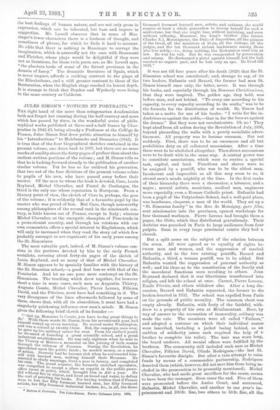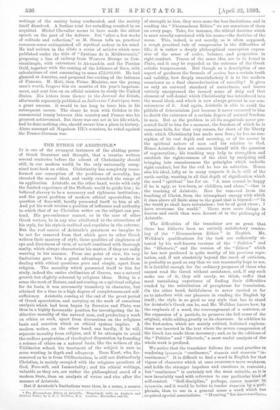JULES SIMON'S "NOTICES ET PORTRAITS."* THE right hand of the
more than octogenarian Academician hath not forgot her cunning during the half-century and more which has passed by since, in the wonderful series of philo- sophical works published at three-and-a-half francs by Char- pentier in 1812-43, being already a Professor at the Collage de France, Jules Simon first drew public attention to himself by his " Introductions " to Malebranche and Descartes (1842). It is true that of the four biographical sketches contained in the present volume, one dates back to 1887, but there are no more marks of senility about the forty pages of preface than about the earliest-written portions of the volume ; and M. Simon tells us that he is looking forward already to the publication of another similar volume. Yet he has so far outlived his generation, that two out of the four divisions of the present volume relate to pupils of his own, who have passed away before their master. Of the men to whom the book is devoted, Caro, Louis Reybaud, Michel Chevalier, and Fustel de Coulanges, the third is the only one whose reputation is European. From a literary point of view, the sketch of Caro is, perhaps, the gem of the volume; it is evidently that of a favourite pupil by the master who was proud of him. But Caro, though noteworthy among philosophers of the second rank in the nineteenth cen- tury, is little known out of France, except in Italy ; whereas Michel Chevalier, as the energetic champion of Free-trade in a protectionist country, and through his relations with our own economists, offers a special interest to Englishmen, which will only be increased when they read the story (of which few probably amongst us are cognizant) of his early years among the St. Simonians.
The most valuable part, indeed, of M. Simon's volume con- sists in the portions devoted by him to the early French socialists, covering about forty-six pages of the sketch of Louis Reybaud, and as many of that of Michel Chevalier. IL Simon appears to be specially familiar with the history of the St. Simonian school,—a good deal less so with that of the Fourierist. And let no one pour mere contempt on the St. Simonia.ns. The teaching which drew together, fog however short a time in some cases, such men as Augustin Thierry, Auguste Comte, Michel Chevalier, Pierre Leroux, Fdlioien David, and the P6reires, must have had something in it. The very divergence of the lines afterwards followed by some of them, shows that, with all its absurdities, it must have had a singularly quickening influence over men's minds. M. Simon gives the following brief sketch of its founder :— Get up, Monsieur le Comte, you have to-day groat things to With these words St. Simon, from his seventeenth year, had himself waked up every morning. He served under Washington, he was a colonel at twenty-three. But, the campaign once over, h ,ee_ dreamed gave up his military career for ever. From his earliest youth
-!'. of founding a great scientific school, and a great
znuu_strial establialiment. He was only eighteen when he sent to the Viceroy of Mexico a memorial on the joining of both oceans through the isthmus of Panama. During the Revolution, he speculated upon the public lands • he needed money, as a means of action. Scarcely had he become' rich when he surrounded him- self with learned men making himself their Mectenas. He married to study marriage, ive a year in luxury, and completed his ruin. The grand seteur, the formerly enriched speculator, was compelled to accept office (mont de pidtd) place as coprst in the public pawn- did without fire in winter, which brought him in X10 a year. He
the cost of Printing and lived on bread and water, to defray were to lose her.or la books. For having written that if France
artists, her fifty _tmyofsoremost learned men, her fifty foremost _industrial leaders, Sm., in all, the three Notices et Portraits, Par Julas /gram Calmann Levy. 1898. thousand foremost learned men, artists, and artisans, she would require at least a whole generation to recoup herself for such a misfortune, but that she might lose, without perishing, and even without suffering. Monsieur, the king's brother (the future Charles X.), Monseigneur, the Duke of Angoul6me, all the princes of the blood, all the ministers of State, all the bishops, all the judges, and the ten thousand richest landowners among those who live nobly,—i.e., doing nothing, the Restoration sued him at law. He won his suit. But he was exasperated by persecution and misery. He discharged a pistol against himself, but the ball reached no organic part, and he lost only an eye. He lived till 1825."
It was not till four years after his death (1829) that the St. Simonian school was constituted; and, strange to say, of its two leaders, Enfantin and Bazard, the former had seen St. Simon himself once only, the latter, never. It was through his books, and especially through his Nouveau Christianisme, that they were inspired. The golden age, they held, was before man, and not behind. "To every one according to his capacity, to every capacity according to its works," was to be the formula for the distribution of wealth. St. Simon had taken as a motto for one of his books : "I write for the in- dustrious as against the noble,—that is, for the bees as against the drones." But they were not revolutionists. Oh no ! They kept aloof from all action during the Revolution of July, 1830, beyond placarding the walls with a purely socialistic adver. tisement. All property was to become common. But not suddenly. First, there was to be an enormous and all but prohibitive duty on all collateral successions. After a time these were to be abolished altogether. Then direct successions were to be dealt with in the same way. A central power was to constitute associations, which were to receive a special
task, capital, and land. Functions and shares were to be assigned by a pontiff, who was to be the ablest man. Incoherent and impossible as all this may seem to us, it stirred men's minds mightily at the time. In the first ranks of their hierarchy there were a shoemaker, a labourer, and a negro ; several artists, musicians, medical men, engineers more especially, even a Roman Catholic priest. Enfantin had been a pupil of the Polytechnic School, had a well-paid place, was handsome, eloquent, a man of the world. They set up a "St. Simonian family" in the Rue de Monsigny, gave fetes, sent missionaries into the provinces, opened workshops for four thousand workmen. Pierre Leroux had brought them a paper, the Globe, which they distributed gratuitously. Their doctrine was preached in Paris to large audiences from four pulpits. Soon in every large provincial centre they had a church.
But a split arose on the subject of the relation between the sexes. All were agreed as to equality of rights be- tween man and woman, and the suppression of marital authority, and to the two existing pontiffs, Bazard and Enfantin, a third, a woman pontiff, was to be added. But Enfantin wanted the suppression of paternal authority as well ; and his ideas as to the constitution of the family and the sacerdotal functions were revolting to others. Jean Reynaud declared that it was libertinism transformed into religion, and left the school at once. Carnot, Pierre Leroux, Emile Pereire, and others withdrew also. After a long dis- cussion, Bazard and Enfantin separated, the former to dis broken-hearted in 1832. The school was expelled from Paris on the grounds of public morality. The common chest was empty already. Enfantin, with forty of the faithful, with- drew to a property of his own at M6nilmontant. Here, by way of answer to the accusation of immorality, celibacy was made the rule. The members were all called "Fathers," and adopted a costume on which their individual names were inscribed, including a jacket hieing behind, as an emblem of solidarity (since each required the help of a. brother to complete his toilet). The hair was worn long,. the beard unshorn. All menial offices were fulfilled by the brethren. The community still included such men as Michel Chevalier, Folicien David, Olinde Rodrigues,—the last St. Simon's favourite disciple. But after a vain attempt to raise funds by means of a commandite partnership, Rodrigues. deserted them (which, however, did not save him from being eluded in the prosecution to be presently mentioned). Michel Chevalier, who had made great sacrifices for the cause, seems
to have been the manager. Soon came the end. Five of them. were prosecuted before the Assize Court, and sentenced, Enfantin, Michel Chevalier, and another to one year's im- prisonment and 100 fr. fine, two others to 50 fr, fine, all tha writings of the society being confiscated, and the society itself dissolved. A further trial for swindling resulted in an acquittal. Michel Chevalier seems to have made the ablest speech on the pare of the defence. But "after a few weeks of solitude and reflection," so M. Simon tells us, practical common-sense extinguished all mystical ardour in his mind. He had written in the Globe a series of articles which were published under the title of " Systeme de la Mediterranee," proposing a line of railway from Western Europe to Con- stantinople, with extensions to Alexandria and the Persian Gulf, together with the cutting of the Isthmus of Suez, with calculations of cost amounting to some £72,000,000. He had glanced at America, and proposed the cutting of the Isthmus of Panama. M. Mole, then Prime Minister, saw the young man's worth, forgave him six months of his year's imprison- ment, and sent him on an official mission to study the United States. His letters from thence to the Journal des Debate, afterwards separately published as Lettres sur l'Amerique, were a great success. It would be too long to trace him in his subsequent career. The share he took with Cobden in the commercial treaty between this country and France was his greatest achievement. But there was one act in his life which, had he done nothing else, should secure him a place in history. Alone amongst all Napoleon M.'s senators, he voted against the Franco. German war.







































 Previous page
Previous page